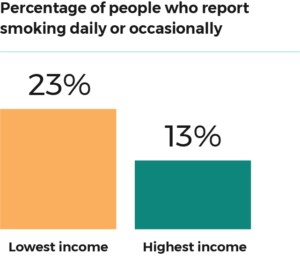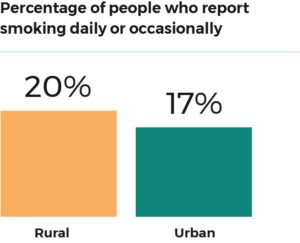Lung cancer and equity report
- Downloads
- Full report (pdf)
- Technical appendix (pdf)
Preventing lung cancer
Prevention plays an important role in reducing the risk of lung cancer. The ability to reduce risk factors is directly related to various social, economic and environmental factors that are often beyond an individual’s control.
What does the inequity look like?
Commercial tobacco use
Tobacco smoking is the leading cause of lung cancer. It is responsible for up to 72 percent of lung cancers in Canada.
The likelihood that someone will smoke is closely related to a complex interaction of social determinants of health and other factors, including tobacco industry influence, which results in higher smoking rates among lower income and rural populations.
How we characterize tobacco use
In this report, tobacco use or smoking refers to the use of commercial tobacco products and does not refer to the use of traditional or sacred tobacco by First Nations or Métis. Traditional or sacred tobacco differs from commercial tobacco in that it is used in ceremonial or sacred rituals for healing and purifying, which is of essential cultural value for many First Nations and Métis communities.
Percentage of people who report smoking daily or occasionally
People with lower income are more likely to smoke than people with higher income. Research shows that low socioeconomic status often interacts with other social, environmental or psychological factors (e.g. race/ethnicity, geographic location, social marginalization, stress) to influence smoking behaviour.

Data source: Statistics Canada, Canadian Community Health Survey (2015-2016)
People living in rural areas are slightly more likely to smoke than people living in urban areas. The literature suggests that people living in rural and remote areas have less access to education and employment opportunities. As a result, they generally have lower levels of education, higher rates of unemployment and lower incomes than urban populations. These factors are exacerbated by less access to health care providers and prevention services, which influence smoking behaviour.

Data source: Statistics Canada, Canadian Community Health Survey (2015-2016)
Environmental and workplace exposure to carcinogens
Exposure to carcinogens in the workplace is associated with up to 15 percent of lung cancers in Canada. People who smoke in addition to being exposed to carcinogens have an even higher risk of developing lung cancer. People who work in certain industries, such as mining, construction and transportation, are more likely to be exposed to carcinogens than people who work in other industries.
Health inequities that result from employment are closely linked to other socioeconomic inequities, such as education and wealth. For example, people who work in the industrial, manufacturing and service industries are more likely to have lower socioeconomic status, including lower levels of education and fewer employment opportunities.
- Downloads
- Full report (pdf)
- Technical appendix (pdf)
